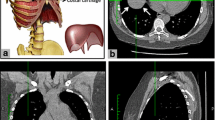Abstract
This paper presents a method for modelling human lungs using knowledge of lung anatomy and High Resolution CT images. The model consists of a symbolic anatomical structure map and an annotated 3D atlas. The model is implemented using Frame structures. Frames provide a good platform for the comprehensive description of anatomical features and for enabling communication between the image data and the symbolic knowledge. A few important landmarks have been determined and used to divide the lung into clinically meaningful regions, which enable accurate mapping of the model to patient data.
Chapter PDF
Similar content being viewed by others
References
Li, B., Christensen, E.G., Hoffman, E.A., et al.: Establishing a Normative Atlas of the Human Lung: Intersubject Warping and Registration of Volumetric CT Images. Acad. Radiol. 10, 255–265 (2003)
Zrimec, T., Sammut, C.: A Medical Image Understanding System. Engineering applications of Artificial Intelligence 10(1), 31–39 (1997)
Author information
Authors and Affiliations
Editor information
Editors and Affiliations
Rights and permissions
Copyright information
© 2004 Springer-Verlag Berlin Heidelberg
About this paper
Cite this paper
Zrimec, T., Busayarat, S., Wilson, P. (2004). A 3D Model of the Human Lung. In: Barillot, C., Haynor, D.R., Hellier, P. (eds) Medical Image Computing and Computer-Assisted Intervention – MICCAI 2004. MICCAI 2004. Lecture Notes in Computer Science, vol 3217. Springer, Berlin, Heidelberg. https://doi.org/10.1007/978-3-540-30136-3_143
Download citation
DOI: https://doi.org/10.1007/978-3-540-30136-3_143
Publisher Name: Springer, Berlin, Heidelberg
Print ISBN: 978-3-540-22977-3
Online ISBN: 978-3-540-30136-3
eBook Packages: Springer Book Archive




